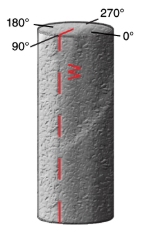Downhole Formatting: Angles
Note: A Datamine eLearning course is available that covers functions described in this topic. Contact your local Datamine office for more details.
The following information applies to controls located on both the Format Downhole screen (3D window) and the Log View Properties table (Columns tab) (Plots, Logs windows)
This information applies to the following downhole formatting styles:
-
Angles
You can enhance the display of your loaded static or dynamic drillhole data using downhole formatting.
Angles formatting can be useful if you wish to display a numeric attribute as an angle. This can be useful to record the orientation (azimuth) of the core, particular where a discontinuity transects it (making the absolute or relative orientation of the core important if you wish to capture faults or bedding planes, for example).

For this downhole formatting type, you have access to the following property menus:
-
Alignment: define how the downhole column is aligned with the sample to which it belongs. This menu also allows you to merge identical records and hide absent data, amongst other useful tools.
-
Filter: apply a filter to your formatting to restrict which sample items are enhanced (see "Drillholes, Object Filters, Columns and Column Filters", below).
-
Graph/Color: define the Y axis range of your angle indicators and other visual formatting options.
-
Text: determine how text is presented (note that the plain Bars Style type can access this panel, but all options are disabled).
-
Width/Margins: controls how your formatting is positioned with respect to the sample interval. Set margins and how wide your formatting will be.
Drillholes, Object Filters, Columns and Column Filters
Drillhole data objects are often coupled with 'downhole column' data to provide more information about the drillhole data. This could be in the form of a histogram, listed grade values, braces, bar charts etc. Downhole columns are formatted separately (using this Format Column screen) from the actual 3D drillhole data (using the Drillholes Folder).
View filtering can be applied
to any object in memory, including drillholes, to control the data that
is displayed at any one time. This is controlled by a filter expression
which can be defined by various methods, including the
However, the situation is slightly more complex where a 'column' filter exists; all downhole columns can be associated with their own filter. In this case, 3D downhole formatting (the downhole 'column' will only be shown if it passes both the object-level and column-level filters.
For example; if a drillhole object was filtered in the Data Object Manager to only show data where X>150, only column and drillhole data would be shown above the 150 position. If an AU downhole column was set to show results only where AU>1.0, downhole column data would only be shown grade values exceed 1.0 ppm and only for unfiltered data (above 150 in X).
To configure angle display formatting on downhole columns:
-
If you are using the Log View Properties page, select the column name in the Columns in View list on the left. If you are formatting 3D downhole columns, your attribute has already been selected.
-
The Style drop-down list displays the default style, or the one currently applied to the downhole column. Select the style you require.
Note: Each Style is supported by its own list of properties that can be modified (see below for details and access to more help).
- Select a property (Alignment, Border/Colour and so on) using the list provided. This will update the panel on the right.
- Update the relevant fields.
- Once all properties have been defined as you want them, click Apply to update the view (either the Plot, Log, Design or 3D view).
Tip: Move all floating dialogs to a second monitor when using this tool, so you can apply changes and review the impact on the view, without having to close screens.
Related topics and activities

